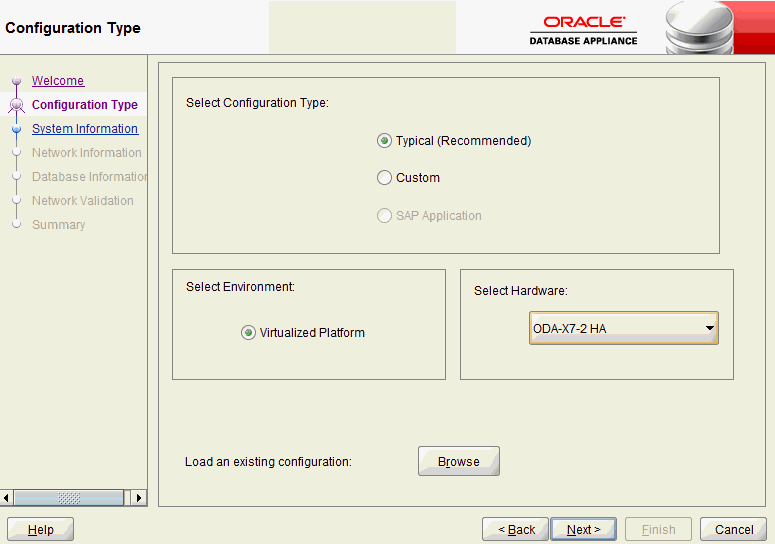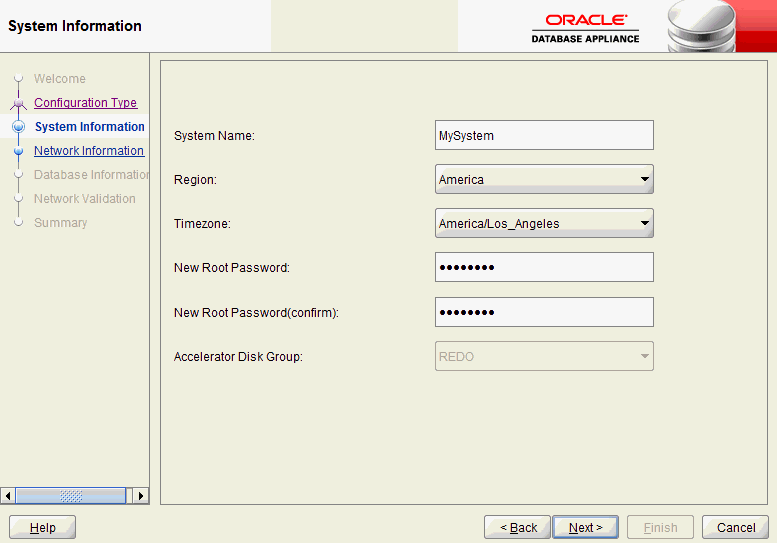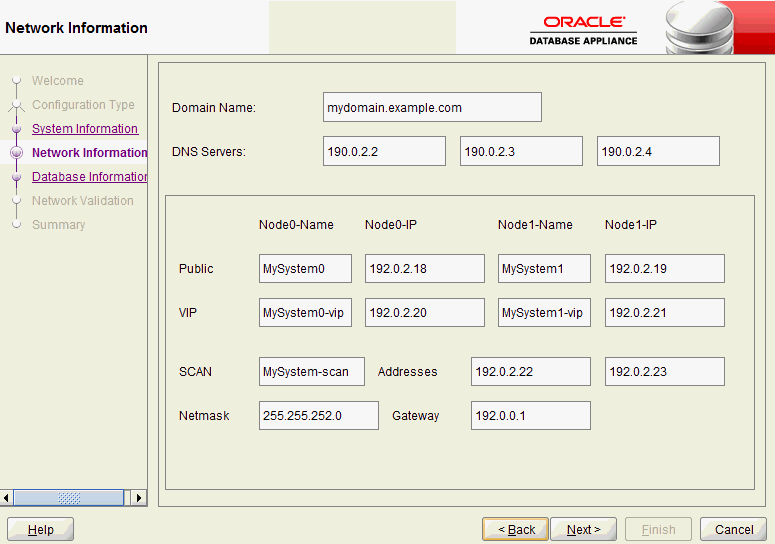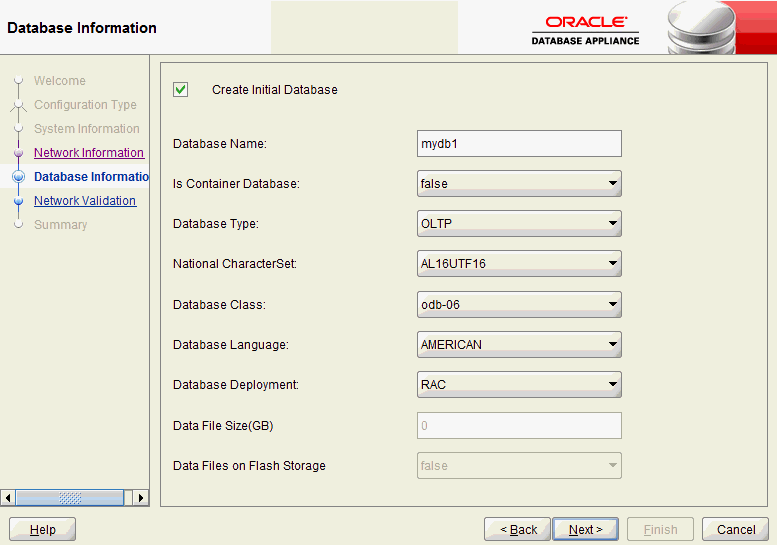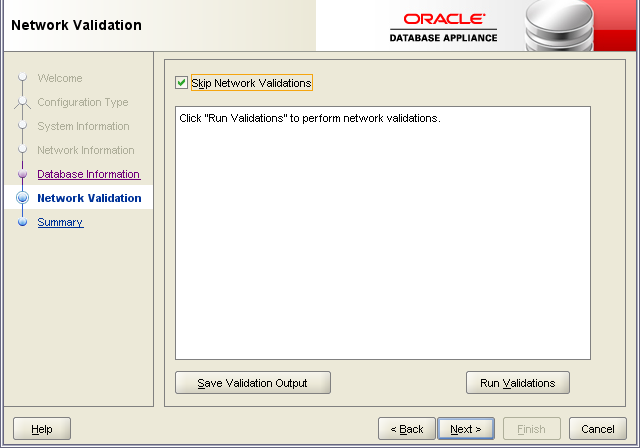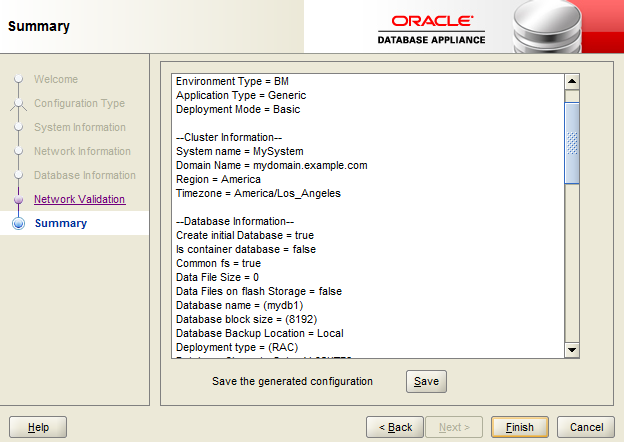2 Preparing for Oracle Database Appliance Installation and Deployment
Complete these setup tasks before Oracle Database Appliance is delivered.
- Registering Your Support Identifier on My Oracle Support
Add your hardware Support Identifier (SI) to your My Oracle Support account profile. - Planning Oracle Database Appliance Configuration Options
Determine how many CPU cores you want to enable, determine your database configuration options, and gather the system information for your Oracle Database Appliance Bare Metal deployment configuration. - Gathering System Requirement Information
Use these checklists to collect information before deploying Oracle Database Appliance. - Creating a Configuration File for a Virtualization Platform
If you want to use the Configurator to create a virtualization platform configuration file before your Oracle Database Appliance X7-2-HA system is delivered, then review these topics.
Registering Your Support Identifier on My Oracle Support
Add your hardware Support Identifier (SI) to your My Oracle Support account profile.
Your hardware SI is supplied when you purchase Oracle Database Appliance. If you acquire new software licenses, then you must also register your new software SIs. The SI registration process can take up to 24 hours to complete.
Note:
You cannot obtain support or software from Oracle without registered SIs.
Planning Oracle Database Appliance Configuration Options
Determine how many CPU cores you want to enable, determine your database configuration options, and gather the system information for your Oracle Database Appliance Bare Metal deployment configuration.
Note:
Do not use Oracle Database Configuration Assistant (DBCA) to create databases on Oracle Database Appliance. Only use Oracle Appliance Manager for database configuration. Deploying Oracle Database instances using Oracle Appliance Manager ensures that these databases are properly configured, optimized, and supported on Oracle Database Appliance.- Selecting an Oracle Database Appliance Configuration
Compare and select an Oracle Database Appliance hardware configuration. - Selecting Operating System Groups and Users
Determine how you want to configure your operating system groups and users and whether or not you want to allow operating system role separation. - Selecting Database Deployment Options
Review the Oracle Database editions that are available for deployment. - Selecting Database Shapes for Oracle Database Appliance
Oracle Database Appliance software includes preconfigured templates, known as shapes, that incorporate Oracle best practices with optimization for different classes of databases.
Selecting an Oracle Database Appliance Configuration
Compare and select an Oracle Database Appliance hardware configuration.
-
Oracle Database Appliance X7-2S is a small configuration designed for smaller or entry-level deployments.
-
Oracle Database Appliance X7-2M is a medium-sized configuration designed for performance.
-
Oracle Database Appliance X7-2-HA is a large configuration designed for larger databases and high-availability.
You cannot expand or reconfigure Oracle Database Appliance to a different configuration. For example, you cannot expand Oracle Database Appliance X7-S to Oracle Database Appliance X7-2M. For Oracle Database Appliance X7-2 configuration details, see the Oracle Database Appliance Owner's Guide.
Selecting Operating System Groups and Users
Determine how you want to configure your operating system groups and users and whether or not you want to allow operating system role separation.
About Operating System Groups and Users
Role separation enables you to configure groups and users to provide separate groups for operating system authentication.
With role separation, a single user owns all of the Oracle installations. All of the databases are installed under a single user. The separation only enables you to have separate users for Oracle and Oracle Clusterware. You can install multiple databases without sharing operating system authentication for system privileges. In addition, each Oracle software installation is owned by a separate installation owner, to provide operating system user authentication for modifications to Oracle Database binaries.
Note:
Any Oracle software owner can start and stop all databases and shared Oracle Grid Infrastructure resources, such as Oracle Automatic Storage Management (Oracle ASM) or Virtual IP (VIP). The job role separation configuration enables database security, it does not restrict user roles in starting and stopping various Oracle Clusterware resources.With Oracle Grid Infrastructure role separation, separate operating system groups provide operating system authentication for Oracle ASM system privileges for storage tier administration. This operating system authentication is separated from Oracle Database operating system authentication. In addition, the Oracle Grid Infrastructure installation owner provides operating system user authentication for modifications to Oracle Grid Infrastructure binaries.
You can configure the appliance with one of four combinations of operating system users, groups, and roles. The default users are the Oracle Database installation owner (oracle) and Oracle Grid Infrastructure installation owner (grid). The default groups are oinstall, dbaoper, dba, asmadmin, asmoper, and asmdba
Default Configuration: Two Users with Six Groups
The default configuration is a combination of two operating system roles for users with six groups.
To configure two users, oracle user with the Oracle User (oracleUser) role and the grid user with the gridUser role, allow operating system role separation.
To configure six groups, oinstall, dbaoper, dba, asmadmin, asmoper, and asmdba, do not select the option to customize users and groups.
Note:
When you select the default configuration in the Web Console, the users and groups do not appear in the interface.Two Custom Users with Six Custom Groups
You can customize the configuration to create two custom users and six custom groups.
To configure two users, allow operating system role separation. The users are populated with the default values, oracle and grid, which you can edit.
To configure six groups, select the option to customize users and groups. The groups are populated with the default values, which you can edit. The default groups are oinstall, dbaoper, dba, asmadmin, asmoper, and asmdba.
The figure shows an example of a custom configuration with the default values populated.
Figure 2-1 Two Custom Users with Six Custom Groups
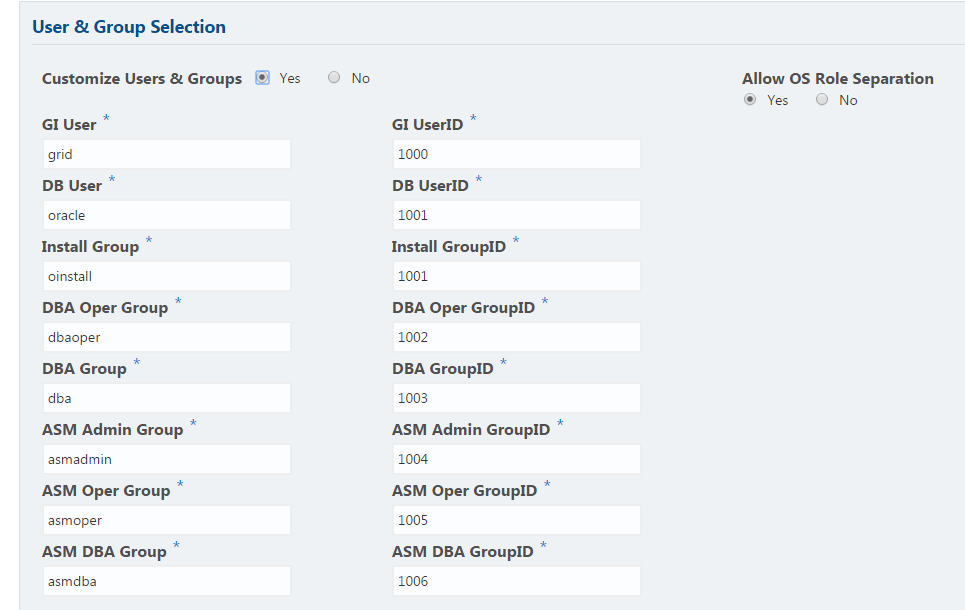
Description of "Figure 2-1 Two Custom Users with Six Custom Groups "
Single Custom User with Six Custom Groups
You can customize the configuration to create a single operating system database user and with six custom groups. The database user can deploy both the grid infrastructure and RDBMS (relational database management system) stacks. You can edit the user name and user ID and you can customize the group names and IDs. Use this option when you deploy SAP.
To configure a single oracle database user with the Oracle User (oracleUser) role, do not allow OS role separation.
To configure six groups, select the option to customize users and groups. The following default groups are populated: oinstall, dbaoper, dba, asmadmin, asmoper, and asmdba. You can customize the groups.
Single User with Two Groups
To configure a single oracle user with the Oracle User (oracleUser) role, do not allow OS role separation.
To configure two groups, oinstall and dba, do not select the option to customize users and groups.
Selecting Database Deployment Options
Review the Oracle Database editions that are available for deployment.
In earlier releases, the database edition was defined at the appliance level during the initial deployment. Beginning with Oracle Database Appliance release 12.2.1.1, Oracle Database editions are defined at the database level, not the appliance level.
Note:
It is important to understand your Oracle Database licensing before you create databases. You cannot use both Oracle Database Enterprise Edition and Standard Edition on the same appliance, either bare metal or virtualized platform.The following Oracle Database editions are available:
-
Oracle Database Enterprise Edition
Oracle Database Enterprise Edition provides the performance, availability, scalability, and security required for mission-critical applications such as high-volume online transaction processing (OLTP) applications, query-intensive data warehouses, and demanding Internet applications.
-
Single-instance Oracle Database Enterprise Edition home
-
Oracle Database options are available
Enterprise Edition for Oracle Database 12.2.0.1, 12.1.0.2, and 11.2.0.4 support Oracle Real Application Clusters (Oracle RAC).
-
-
Oracle Database Standard Edition 2
Oracle Database Standard Edition 2 delivers unprecedented ease of use, power, and performance for workgroup, department-level, and Web applications.
Standard Edition 2 for Oracle Database 12.1.0.2 supports Oracle RAC and RAC One.
-
Oracle Database Standard Edition One
Oracle Database Standard Edition One delivers unprecedented ease of use, power, and performance for workgroup, department-level, and Web applications.
Standard Edition One for Oracle Database 11.2.0.4. Standard Edition One does not support Oracle RAC.
-
Oracle Database Standard Edition
Oracle Database Standard Edition delivers the unprecedented ease of use, power, and performance of Standard Edition One, with support for larger machines and clustering of services with Oracle RAC.
Standard Edition for Oracle Database 11.2.0.4 supports Oracle RAC and RAC One.
Oracle Real Application Clusters (RAC) One Node is an always online single instance of an Oracle RAC enabled database running on one node in a cluster.
Note:
Review the Database Licensing Information User Manual for the Oracle Database release to review supported options and products.
Selecting Database Shapes for Oracle Database Appliance
Oracle Database Appliance software includes preconfigured templates, known as shapes, that incorporate Oracle best practices with optimization for different classes of databases.
Because of differences in CPU counts, memory size, and other resources available with different Oracle Database Appliance models, some shapes are not supported on all models.
Each Oracle Database shape has different workload profile and performance characteristics:
-
Memory requirements, which are calculated from the System Global Area (SGA), and Program Global Area (PGA) sizes
-
Processing requirements, which are calculated from the number of processes
-
Logging requirements, which are based on log buffer size, and online redo log size
Oracle Database Appliance shapes are tuned for the size of each database instance workload and are designed to run on a specific number of cores.
Note:
Oracle strongly recommends that you use the Oracle Database Appliance shapes. These shapes implement best practices, and are configured specifically for Oracle Database Appliance.
Gathering System Requirement Information
Use these checklists to collect information before deploying Oracle Database Appliance.
- List of Information You Need Before Deployment
Collect security, storage, and network information required to prepare for deploying Oracle Database Appliance X7-2S, X7-2M, and X7-2-HA. - Checklist for System Details
Use the checklist to gather system information that you need to obtain for Oracle Database Appliance. Record the values for your system. - Checklist for Custom Network IP Address Configuration
Use the checklist to identify the IP addresses required for Oracle Database Appliance.
List of Information You Need Before Deployment
Collect security, storage, and network information required to prepare for deploying Oracle Database Appliance X7-2S, X7-2M, and X7-2-HA.
- Security Requirements
Review your security requirements forrootpasswords. - Storage Administration Requirements
Storage administration is integrated into Oracle Database Appliance. No additional storage configuration is required. - Network Administration Requirements for Single Node Systems
Review the network administration requirements and recommendations for Oracle Database Appliance X7-2S and X7-2M. - Network Administration Requirements for Multi-Node Systems
Review the network administration requirements and recommendations for Oracle Database Appliance X7-2-HA multi-node systems.
Security Requirements
Review your security requirements for root passwords.
-
What root password should you use for Oracle Database Appliance? Root passwords should comply with your system security requirements.
-
Secure operating systems are an important basis for general system security. Ensure that your operating system deployment is in compliance with common security practices.
Storage Administration Requirements
Storage administration is integrated into Oracle Database Appliance. No additional storage configuration is required.
Oracle Database Appliance uses Oracle Automatic Storage Management Cluster File System (Oracle ACFS) or Oracle Automatic Storage Management (Oracle ASM) and include the following:
-
Integrated storage for operational files (operating system, Oracle Grid Infrastructure home, Oracle Database homes, tools). Operational files are stored on mirrored internal system disks.
-
DATA (user data and database files).
-
RECO (database redo logs, archive logs, and recovery manager backups).
-
REDO (database redo logs). X7-2-HA only.
-
FLASH (hot table data) X7-2-HA with HDD drive configuration only.
-
Operational files are stored on mirrored internal system disks.
Based on your environment and backup location, you can configure the storage capacity for the DATA diskgroup to be anywhere from 10% to 90%, with the remaining percentage for RECO diskgroup. For example, you might assign 80% of the storage capacity for DATA and 20% for RECO.
Note:
Depending on the model, you have the option to expand the system’s storage capacity.
Related Topics
Network Administration Requirements for Single Node Systems
Review the network administration requirements and recommendations for Oracle Database Appliance X7-2S and X7-2M.
The network administration requirements and recommendations are as follows:
-
Determine the type of network interface for your public network and know the details for your generic and public network.
-
Oracle recommends that you resolve addresses using Domain Name System (DNS) servers.
-
All names must conform to the RFC 952 standard, which permits alphanumeric characters and hyphens ("-"), but does not allow underscores ("_").
-
Provide an IP address for the public interface (
btbond1).
Depending on your network setup, you can use one of the following available bonds:
-
Onboard NIC 10GBase-T (copper) ports
-
25GbE SFP+ (fiber) PCIe card
As part of the initial setup, you must use the command configure-first through Oracle ILOM's remote console to plumb the public network.
Answer These Questions
Determine the answers to the following questions:
-
What is your domain name?
For example:
example.com. -
Do you want to use DNS?
(Optional) Ensure that the names and addresses that you provide for network configuration are configured in your Domain Name System (DNS) servers. DNS is optional, but recommended. If you want to use DNS, then obtain your DNS server addresses. The addresses that you provide are configured in the
/etc/hostsfile to provide IP name and address resolution, even if a DNS server is not available. -
Do you have a Network Time Protocol (NTP) service configured for each server, so that the local system time for each server is synchronized?
-
Which network interface do you want to use for your public network?
-
10GBase-T (copper)
-
25GbE SFP+ (fiber)
-
-
What are the details for your public network? To connect to the system, you require the following information:
-
Host name
For example:
myhost -
IP address
For example:
192.0.2.18 -
Netmask for the public network
For example:
255.255.252.0 -
Gateway for the public network
For example:
192.0.2.1
-
-
What are the Oracle Integrated Lights Out Manager (Oracle ILOM) details needed to manage Oracle Database Appliance independent of the operating system?
Collect the following Oracle ILOM details from your network administrator:
-
Oracle ILOM host name
For example:
myilom1 -
Oracle ILOM IP address
For example:
10.0.0.3 -
Netmask for the Oracle ILOM network
For example:
255.255.255.0 -
Gateway for the Oracle ILOM network
For example:
10.0.0.1
-
Network Administration Requirements for Multi-Node Systems
Review the network administration requirements and recommendations for Oracle Database Appliance X7-2-HA multi-node systems.
The network administration requirements and recommendations are as follows:
-
Determine the type of network interface for your public network and know the details for your generic and public network.
-
Oracle recommends that you resolve addresses using Domain Name System (DNS) servers.
-
All names must conform to the RFC 952 standard, which permits alphanumeric characters and hyphens ("-"), but does not allow underscores ("_").
-
Provide an IP address for the public interface (
btbond1) for each node. This interface is bond0, or Eth1 on Oracle Database Appliance Virtualized Platform, (a bond of Eth2 and Eth3), which is used for the host IP address for the node.For Oracle Database Appliance X7-2-HA, a correctly configured appliance requires at least six public addresses on the same subnet for the nodes:
-
A public IP name and address for each node
-
A virtual IP name and address for each node
-
Two addresses that resolve to the SCAN for the cluster
-
Depending on your network setup, you can use one of the following available bonds:
-
Onboard NIC 10GBase-T (copper) ports
-
25GbE SFP+ (fiber) PCIe card
As part of the initial setup, you must use the odacli configure-first command to configure a public network through Oracle ILOM to get access to the machine.
Be prepared to provide a netmask and gateway for the network when you configure the network connection for Oracle Database Appliance.
Domain Name System (DNS) Servers
For multi-node systems, ensure that the names and addresses that you provide for network configuration are configured in your DNS servers. The addresses that you provide are configured in the /etc/hosts file to provide IP name and address resolution, even if a DNS server is not available.
You have the option to connect either to a copper, or to a fiber public network. To connect to a fiber network you must purchase the configuration with 25GbE SFP+ fiber cards. The InfiniBand interconnect is not supported if you purchase the configuration with 25GbE SFP+ fiber cards. Ensure that your network planning is based on the correct type of public network.
Oracle recommends that you resolve addresses using a DNS server, so that you can use Single Client Access Names (SCANs). Having a single name to access the cluster enables the client to use the EZConnect client and the simple JDBC thin URL to access any Oracle Database running in the cluster, independent of the active servers in the cluster. The SCAN provides load-balancing and failover for client connections to these databases. The SCAN works as a cluster alias for Oracle Databases in the cluster.
If you deploy without using a DNS server, then you can add a DNS server later, and add SCANs. If you add SCANs, then you must specify additional VIP addresses for those SCANs.
Answer These Questions
Determine the answers to the following questions:
-
What is your domain name?
For example:
example.com. -
Do you want to use DNS?
(Optional) Ensure that the names and addresses that you provide for network configuration are configured in your Domain Name System (DNS) servers. DNS is optional, but recommended. If you want to use DNS, then obtain your DNS server addresses. The addresses that you provide are configured in the
/etc/hostsfile to provide IP name and address resolution, even if a DNS server is not available. -
Do you have a Network Time Protocol (NTP) service configured for each server, so that the local system time for each server is synchronized?
If you have NTP servers and you want to synchronize time between Oracle Database Appliance nodes using NTP, then be prepared to provide the addresses for the servers. If you do not provide addresses for NTP servers, then Oracle Grid Infrastructure software configures time synchronization between nodes using Cluster Time Synchronization Service (CTSS).
-
Do you want to plug in the public IP address cables to redundant switches, so that you can avoid a single point of failure for Oracle Database Appliance? Oracle recommends that you use redundant switches for High Availability.
-
Which network interface do you want to use for your public network?
-
10GBase-T (copper)
-
25GbE SFP+ (fiber)
-
-
What are the details for your public network? To connect to the system, you require the following information:
-
Host name
For example:
myhost -
IP address
For example:
192.0.2.18 -
Netmask for the public network
For example:
255.255.252.0 -
Gateway for the public network
For example:
192.0.2.1
-
-
(For the X7-2-HA virtualized platform only) VLAN ID for public network (for example, 100)
-
(For the X7-2-HA virtualized platform only) Do you want the ability to configure additional networks?
-
What are the Oracle Integrated Lights Out Manager (Oracle ILOM) details needed to manage Oracle Database Appliance independent of the operating system?
Collect the following Oracle ILOM details from your network administrator:
-
Oracle ILOM host name for each node
For example:
myilom1andmyilom2Oracle ILOM IP address for each node
For example:
10.0.0.3and10.0.0.4 -
Netmask for the Oracle ILOM network
For example:
255.255.255.0 -
Gateway for the Oracle ILOM network
For example:
10.0.0.1
-
Checklist for System Details
Use the checklist to gather system information that you need to obtain for Oracle Database Appliance. Record the values for your system.
Table 2-1 Checklist for System Configuration Information for Oracle Database Appliance
| System Information | Description |
|---|---|
|
Host Name |
The name for the Oracle Database Appliance System. The name must conform with the RFC 952 standard, which allows alphanumeric characters and hyphens ( - ), but does not allow underscores ( _ ). The name should not begin with a numeral or hyphen and should not end in a hyphen. Oracle recommends that you use all lowercase characters for the host name. |
|
Domain Name |
Your domain name. For example: |
|
Region |
The region where you plan to operate the Oracle Database Appliance system. |
|
Timezone |
The time zone where you plan to operate the Oracle Database Appliance system. |
|
Diskgroup Redundancy |
Determine the redundancy level for DATA, RECO, and FLASH: Normal redundancy (two way mirror) or High redundancy (three way mirror). If you select High redundancy, then DATA, RECO, and FLASH are all High redundancy. If the system has less than five (5) NVMe storage devices, then redundancy is automatically set to Normal and this field does not appear. |
|
Percentage of Storage Reserved for Data |
Determine the amount of reserves for DATA storage. The percentage must be a whole number between 10 and 90 and determines how the NVMe Disks are partitioned between DATA and RECO. For example, if you specify 80, then 80% of storage is reserved for DATA and the remaining 20% is for RECO. |
|
Master Password |
The password set for the root password of the system, OS users, database users, and pdbadmin. The password is also used to set the database |
|
DNS Server |
(Optional) DNS server details. |
|
NTP Server |
(Optional) Network Time Protocol (NTP) service details. |
|
Network Information for the client access network |
Obtain the following network information for the public network:
|
|
Network Information for the Oracle Integrated Lights Out Manager (ILOM) network |
(Optional) Obtain the following ILOM network information:
|
|
User and group information |
Determine how you want to configure your users and groups and whether or not you want to allow operating system role separation. The default is two users with six groups. |
|
Initial Database Details (if you want to create one during deployment) |
(Optional) If you choose to create an initial database during deployment, determine the following configuration details:
|
|
Oracle Auto Service Request (Oracle ASR) information |
(Optional) Do you want to Configure and enable Oracle ASR at deployment or later? |
Checklist for Custom Network IP Address Configuration
Use the checklist to identify the IP addresses required for Oracle Database Appliance.
Note:
Oracle does not recommend changing the default Host Private Address. If there is a business need to change the address, such as an IP address conflict, use the commandodacli update-network to update the private network before using the Web Console to deploy the appliance. You cannot change the private network after deploying the appliance.Table 2-2 Default IP Address Requirements for Oracle Database Appliance X7-2S and X7-2M
| Type of IP | Number of IP Addresses Needed | IP Address Default Values | Your Values As Applicable |
|---|---|---|---|
|
Client Access Network for the server host |
1 |
No default |
IP: |
|
(Recommended) Oracle Integrated Lights Out Manager (ILOM) |
1 |
No default |
IP: |
|
Host Private Addresses |
Not applicable |
192.168.16.24 |
Not applicable: the private addresses are defined before deployment and should not be changed |
|
DNS |
Up to 3 |
No default |
IP: |
|
(Optional) NTP |
Up to 3 |
No default |
IP: |
|
Netmask |
1 |
No default |
IP: |
|
Gateway |
1 |
No default |
IP: |
|
(Optional) Guest VM IPs |
As needed |
No default |
IP: |
Table 2-3 Default IP Address Requirements for Oracle Database Appliance X7-2-HA
| Type of IP | Number of IP Addresses Needed | IP Address Default Values | Your Values As Applicable |
|---|---|---|---|
|
Client Access Network for the server hosts |
2 |
No default |
IP: |
|
VIP |
2 |
No default |
IP: |
|
SCAN |
2 |
No default |
IP: |
|
(Recommended) Oracle Integrated Lights Out Manager (ILOM) |
1 |
No default |
IP: |
|
Host Private Addresses (bare metal platform) |
Not applicable |
Node 0:
Node 1:
|
Not applicable: the private addresses are defined before deployment and should not be changed. On bare metal, the interconnect uses High Availability IP (HAIP) addresses. The interfaces are |
|
Host Private Addresses (virtualized platform) |
Not applicable |
Dom0:
ODA_Base:
|
On a virutalized deployment, the interconnect is bonded and called |
|
DNS |
Up to 3 |
No default |
IP: |
|
(Optional) NTP |
Up to 3 |
No default |
IP: |
|
Netmask |
1 |
No default |
IP: |
|
Gateway |
1 |
No default |
IP: |
|
(Optional) Guest VM IPs |
As needed |
No default |
IP: |
Creating a Configuration File for a Virtualization Platform
If you want to use the Configurator to create a virtualization platform configuration file before your Oracle Database Appliance X7-2-HA system is delivered, then review these topics.
- About the Standalone Oracle Database Appliance Configurator
Use the standalone Oracle Database Appliance Configurator to create an Oracle Database Appliance Virtualization Platform offline deployment plan and validate your network settings before the actual deployment. - Running the Standalone Oracle Database Appliance Configurator
Download and run the standalone Oracle Database Appliance Configurator to create a configuration file for the Oracle Database Appliance Virtualization Platform.
About the Standalone Oracle Database Appliance Configurator
Use the standalone Oracle Database Appliance Configurator to create an Oracle Database Appliance Virtualization Platform offline deployment plan and validate your network settings before the actual deployment.
If you prefer to configure your system at the time you deploy the virtualization platform, then you can wait and use the online Configurator that is part of virtualization image for Oracle Database Appliance.
The standalone Oracle Appliance Manager Configurator is a Java-based tool that enables you to generate your virtualization platform deployment plan and validate your network settings before the actual deployment. If you want to use this tool before deployment, then you must download and run the Configurator on a local client system. The local client can be a Linux, UNIX, MAC, or Windows system.
The Configurator provides two types of configuration: Typical and Custom. The Typical configuration is recommended in most cases. Choose the Custom configuration option if you want to configure additional or alternate network interfaces, or if you want to override the default values for one or more of the following:
-
Database block size, language, territory, backup file location, or disk redundancy level for the DATA and RECO disk groups
-
Oracle Integrated Lights Out Manager (Oracle ILOM) server.
-
Oracle Auto Service Request (Oracle ASR) configuration. You can configure Oracle ASR after deployment.
-
Oracle Cloud File System mount point and file system size. Configure a Cloud FS if you want a non-database file location accessible by both nodes.
-
Network Time Protocol service server.
To see the default values for your version of Oracle Database Appliance software before choosing the Typical or Custom option, run the Configurator using the Custom option.
Oracle recommends that you use the Network Validation page in the Configurator to test your network settings. To test the network settings, you must run the Configurator on a client server that is connected to same network subnet that you intend to use for Oracle Database Appliance. If you do not do this, then the validation fails, regardless of whether or not you have completed required configuration.
At the end of an offline Configurator session, you can save your deployment plan in a configuration file. You can use the Configurator to edit your settings. When you are ready to deploy Oracle Database Appliance, copy this configuration file to the appliance, and run the online Oracle Appliance Manager Configurator to import and deploy your saved plan. You can also print the file's content and use the printout to review your configuration entries for deployment planning purposes and as a checklist for setting up your external network configuration.
Running the Standalone Oracle Database Appliance Configurator
Download and run the standalone Oracle Database Appliance Configurator to create a configuration file for the Oracle Database Appliance Virtualization Platform.
In most cases, Oracle recommends that you select the typical configuration. Select the custom option if you want to configure additional or alternate network interfaces, or if you want to override the default values. To see the default values for your version of Oracle Database Appliance software before choosing the Typical or Custom option, run the Configurator using the Custom option.
The steps described here enable you to create a typical virtualized platform configuration file.
